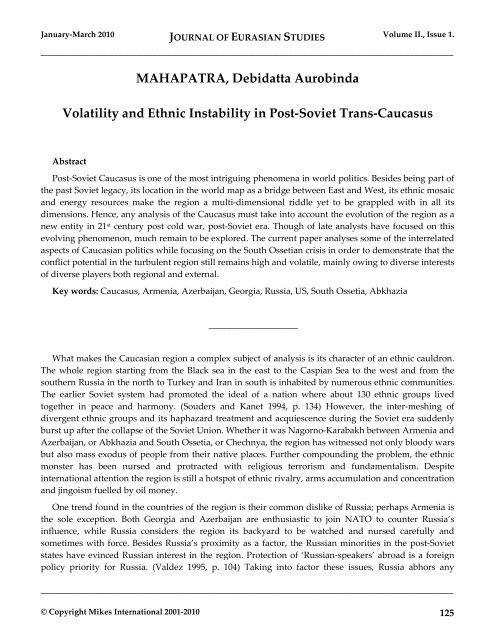EurasianStudies_0110..
EurasianStudies_0110..
EurasianStudies_0110..
Create successful ePaper yourself
Turn your PDF publications into a flip-book with our unique Google optimized e-Paper software.
January-March 2010 JOURNAL OF EURASIAN STUDIES Volume II., Issue 1.<br />
_____________________________________________________________________________________<br />
MAHAPATRA, Debidatta Aurobinda<br />
Volatility and Ethnic Instability in Post-Soviet Trans-Caucasus<br />
Abstract<br />
Post-Soviet Caucasus is one of the most intriguing phenomena in world politics. Besides being part of<br />
the past Soviet legacy, its location in the world map as a bridge between East and West, its ethnic mosaic<br />
and energy resources make the region a multi-dimensional riddle yet to be grappled with in all its<br />
dimensions. Hence, any analysis of the Caucasus must take into account the evolution of the region as a<br />
new entity in 21 st century post cold war, post-Soviet era. Though of late analysts have focused on this<br />
evolving phenomenon, much remain to be explored. The current paper analyses some of the interrelated<br />
aspects of Caucasian politics while focusing on the South Ossetian crisis in order to demonstrate that the<br />
conflict potential in the turbulent region still remains high and volatile, mainly owing to diverse interests<br />
of diverse players both regional and external.<br />
Key words: Caucasus, Armenia, Azerbaijan, Georgia, Russia, US, South Ossetia, Abkhazia<br />
____________________<br />
What makes the Caucasian region a complex subject of analysis is its character of an ethnic cauldron.<br />
The whole region starting from the Black sea in the east to the Caspian Sea to the west and from the<br />
southern Russia in the north to Turkey and Iran in south is inhabited by numerous ethnic communities.<br />
The earlier Soviet system had promoted the ideal of a nation where about 130 ethnic groups lived<br />
together in peace and harmony. (Souders and Kanet 1994, p. 134) However, the inter-meshing of<br />
divergent ethnic groups and its haphazard treatment and acquiescence during the Soviet era suddenly<br />
burst up after the collapse of the Soviet Union. Whether it was Nagorno-Karabakh between Armenia and<br />
Azerbaijan, or Abkhazia and South Ossetia, or Chechnya, the region has witnessed not only bloody wars<br />
but also mass exodus of people from their native places. Further compounding the problem, the ethnic<br />
monster has been nursed and protracted with religious terrorism and fundamentalism. Despite<br />
international attention the region is still a hotspot of ethnic rivalry, arms accumulation and concentration<br />
and jingoism fuelled by oil money.<br />
One trend found in the countries of the region is their common dislike of Russia; perhaps Armenia is<br />
the sole exception. Both Georgia and Azerbaijan are enthusiastic to join NATO to counter Russia’s<br />
influence, while Russia considers the region its backyard to be watched and nursed carefully and<br />
sometimes with force. Besides Russia’s proximity as a factor, the Russian minorities in the post-Soviet<br />
states have evinced Russian interest in the region. Protection of ‘Russian-speakers’ abroad is a foreign<br />
policy priority for Russia. (Valdez 1995, p. 104) Taking into factor these issues, Russia abhors any<br />
_____________________________________________________________________________________<br />
© Copyright Mikes International 2001-2010 125

















